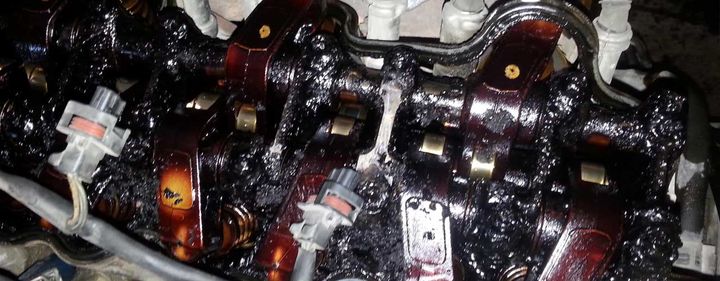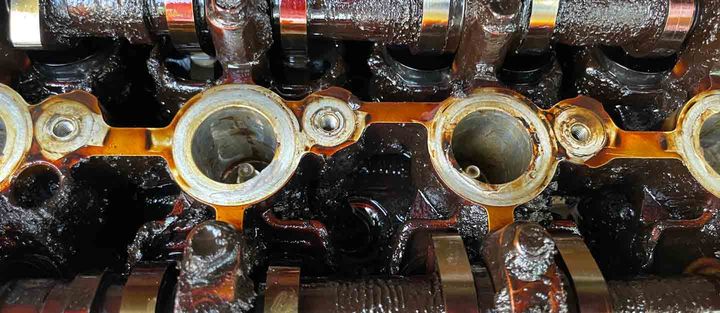


Engine sludge is a thick, sticky deposit that forms when engine oil degrades and mixes with contaminants such as dirt, moisture, and combustion byproducts. It accumulates within the engine over time, clogging vital oil passages and preventing proper lubrication of the engine's moving parts.

Engine sludge is a thick, tar-like substance that accumulates within the engine's internal components, such as the crankcase, oil passages, and valve train. It's formed when the engine oil breaks down and mixes with contaminants like dirt, moisture, and unburnt fuel particles.
Over time, this sludge can clog vital oil passages, restricting proper lubrication and leading to premature wear and potential engine failure. Here's a table illustrating the consequences of engine sludge buildup:
| Consequence | Description |
|---|---|
| Restricted Oil Flow | Sludge can block oil passages, preventing proper lubrication of critical components. |
| Increased Friction | With inadequate lubrication, metal-to-metal contact increases, leading to excessive wear. |
| Overheating | Sludge buildup can impede heat dissipation, causing the engine to overheat. |
| Reduced Efficiency | Sludge can interfere with the engine's combustion process, resulting in decreased fuel efficiency. |
| Engine Failure | In severe cases, sludge buildup can lead to catastrophic engine failure. |
As a mechanic, I've learned to identify the telltale signs of engine sludge through various diagnostic methods. Here are some common symptoms to watch out for:
Oil Condition: If the engine oil appears thick, dark, and gritty, it's a clear sign that sludge has formed.
Visual Inspection: Removing the oil filler cap and inspecting the valve cover area with a flashlight can reveal sludge deposits.
Exterior Buildup: Oil splatters or sludge buildup on the exterior engine components can indicate an internal sludge problem.
Oil Pan Inspection: In severe cases, dropping the oil pan and inspecting the interior can reveal significant sludge accumulation on the walls and components.
I vividly remember a customer who brought in their vehicle complaining of rough idling and decreased fuel efficiency. Upon inspection, I discovered a thick layer of sludge coating the engine's internal components. The culprit? Infrequent oil changes and short trip driving, which prevented the engine from reaching optimal operating temperatures.
This particular case highlights the importance of regular maintenance and understanding the factors that contribute to sludge formation.
While engine sludge can have various underlying causes, some factors are more prevalent than others. Let's explore the main culprits:
Failing to change the engine oil at recommended intervals is the primary cause of sludge buildup. As oil breaks down over time, it loses its lubricating properties, and contaminants accumulate, leading to sludge formation.
This is why adhering to the manufacturer's recommended oil change intervals is crucial. Here's a table illustrating the recommended oil change intervals for different driving conditions:
| Driving Condition | Oil Change Interval |
|---|---|
| Normal Driving | Every 5,000 - 7,500 miles or 6 - 12 months |
| Severe Driving | Every 3,000 - 5,000 miles or 3 - 6 months |
Severe driving conditions include:
Frequent short trips
Extreme temperatures
Towing or hauling heavy loads
Dusty or off-road environments
Engines may not reach optimal operating temperatures during short trips, preventing proper combustion of contaminants and moisture buildup. This can contribute to sludge formation, especially in stop-and-go city driving conditions.
To mitigate this issue, it's recommended to combine short trips into longer drives whenever possible, allowing the engine to reach its optimal operating temperature. Additionally, more frequent oil changes may be necessary to compensate for the increased strain.
Using low-grade or incorrect oil can accelerate the breakdown process and sludge formation. Always use high-quality oil that meets the manufacturer's specifications for your vehicle.
Here's a table comparing the characteristics of high-quality and low-quality oils:
| Characteristic | High-Quality Oil | Low-Quality Oil |
|---|---|---|
| Viscosity Stability | Maintains viscosity over time | Viscosity breaks down quickly |
| Additive Package | Advanced additives for protection | Minimal or ineffective additives |
| Contaminant Resistance | Resists sludge and varnish formation | Prone to sludge and varnish buildup |
| Engine Compatibility | Meets manufacturer specifications | May not be compatible with engine design |
Leaks allowing coolant or unburnt fuel to mix with the engine oil can lead to sludge buildup. These contaminants can accelerate the breakdown of the oil and contribute to sludge formation.
Addressing these leaks promptly is essential to prevent further damage and sludge buildup. Regular inspections and prompt repairs can help mitigate this issue.
As a mechanic, I've developed a comprehensive approach to addressing engine sludge issues. Here are the steps I typically recommend:

Infrequent Oil Changes: Perform an engine flush, replace the oil and filter, and follow recommended service intervals moving forward.
Short Trip Driving: Combine short trips into longer drives to allow the engine to reach operating temperature. Consider more frequent oil changes to compensate for the increased strain.
Low-Quality Oil: Switch to high-quality oil meeting the manufacturer's specifications for your vehicle.
Coolant/Fuel Contamination: Identify and repair the source of the leak, then perform an engine flush and oil change.
Prevention is key when it comes to engine sludge. Here are some proactive measures I recommend:
Follow Recommended Service Intervals: Adhere to the manufacturer's recommended oil change intervals and use the specified oil grade/type for your vehicle.
Avoid Excessive Idling and Short Trips: When possible, avoid excessive idling and combine short trips into longer drives to allow the engine to reach optimal operating temperatures.
Regular Inspections: Check for leaks regularly and address any issues promptly to prevent contamination.
Use Fuel System Cleaners and Oil Additives: Consider using fuel system cleaners and oil additives designed to prevent sludge buildup and maintain engine cleanliness.
The cost of addressing engine sludge can vary significantly depending on the severity and the chosen repair method. Here's a general breakdown of potential costs:
Engine Flush and Oil Change: $100 - $300
Professional Engine Cleaning Service: $500 - $1,000
Engine Rebuild or Replacement (Severe Sludge Damage): $3,000 - $7,000 or more, depending on the vehicle.
It's important to address sludge issues promptly, as neglecting them can lead to more extensive and costly repairs or even complete engine failure down the line.
Engine sludge is a serious issue that can significantly impact your vehicle's performance and longevity. As a mechanic, I've witnessed firsthand the devastating effects of neglecting this problem. By recognizing the symptoms, understanding the causes, and implementing preventive measures, you can protect your engine and avoid costly repairs.
Remember, regular maintenance and adhering to recommended service intervals are key to keeping your engine running smoothly and sludge-free. Don't hesitate to consult with a professional mechanic if you suspect sludge buildup or have any concerns about your vehicle's engine health.
Stay vigilant, and keep your engine clean – your car will thank you for it!
Infrequent oil changes and using low-quality oil are the primary causes of engine sludge. Sludge forms when oil breaks down and mixes with contaminants over time.
Look for symptoms like thick, dark engine oil, decreased fuel efficiency, the check engine light turning on, and knocking or tapping noises from the engine.
Yes, short trips that don't allow the engine to reach optimal operating temperatures can contribute to sludge formation by preventing proper oil flow.
Untreated engine sludge can clog oil passages, restrict lubrication, cause overheating, increased friction, and potentially lead to complete engine failure.
Follow the manufacturer's recommended oil change intervals, which are typically every 5,000-7,500 miles or 6-12 months for normal driving conditions.
Yes, synthetic oils are more resistant to thermal breakdown and often contain better additive packages to fight sludge formation compared to conventional oils.
An engine flush is a chemical additive that helps break down and dissolve sludge deposits, allowing them to be flushed out during an oil change.
The cost can range from $100-$300 for an engine flush and oil change to $3,000-$7,000 or more for an engine rebuild or replacement in severe cases.
Yes, coolant or unburnt fuel leaking into the engine oil can contaminate it and accelerate the breakdown process, leading to sludge formation.
Use high-mileage synthetic oils formulated with enhanced additives, follow strict maintenance schedules, and consider engine flush treatments periodically.

Sarah isn't your average gearhead. With a double major in Mechanical Engineering and Automotive Technology, she dived straight into the world of car repair. After 15 years of turning wrenches at dealerships and independent shops, Sarah joined MICDOT to share her expertise and passion for making cars run like new. Her in-depth knowledge and knack for explaining complex issues in simple terms make her a valuable asset to our team.











